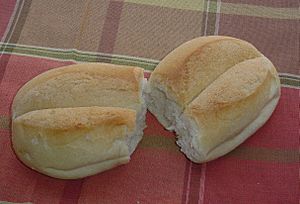Marraqueta facts for kids
 |
|
| Alternative names |
|
|---|---|
| Type | Wheat bread roll |
| Place of origin | |
| Main ingredients | Wheat flour, salt, water, leavening agent |
| 267 kcal (1118 kJ) | |
A marraqueta is a popular type of bread roll. It's also known by other names, like pan francés (which means 'French bread' in Spanish). This bread is made from wheat flour, salt, water, and yeast. It has a super crunchy outside and is very popular in many countries.
You can find marraqueta in South America, especially in Bolivia, Brazil, Chile, and Peru. It's also eaten in Argentina and Uruguay. Beyond South America, it's popular in Portugal, Mallorca (an island in Spain), Hong Kong, and Macau. The oldest records of the name "marraqueta" suggest it first came from Bolivia.
Contents
Names for Marraqueta
This tasty bread has many different names depending on where you are! Here are some of them:
- Argentina: pan felipe (Felipe bread)
- Bolivia: Marraqueta, pan de batalla (battle bread)
- Brazil: pão francês (French bread), pão cacetinho, cacetinho, pão de sal (salt bread), pão de trigo (wheat bread), pão de água (water bread), aguado, careca, jacó
- Chile: marraqueta, pan batido (whipped bread), pan francés
- Hong Kong & Macau: zyu1 zai2 baau1 (豬仔包, piggy bun)
- Mallorca: llonguet, panet francès (French bread roll)
- Mozambique: pão de água
- Paraguay: pan felipe
- Peru: marraqueta, pan francés
- Portugal: paposseco, carcaça
- Uruguay: pan marsellés (Marseille bread)
Marraqueta Around the World
Bolivia
In Bolivia, marraqueta is sometimes called pan de batalla, which means "battle bread." The recipe for this bread arrived in La Paz, Bolivia, in 1908. It was brought by a Greek immigrant named Michel Jorge Callispieris. He came from Chios island, and the bread from both places has a similar crunchy texture and a slightly salty taste.
Bolivian marraqueta usually weighs about 60-75 grams. It's sold individually and is very popular in the cities of La Paz and El Alto. Bakers make it in big ovens during the night so it can be sold fresh and crunchy by vendors every morning. The marraqueta from La Paz was even declared a special cultural heritage in 2006!
Brazil
In Brazil, this bread has many different names depending on the region. Some common names include pão francês (French bread), pão de sal (salt bread), and pão de água (water bread). It's often used to make a popular breakfast dish called pão na chapa, which is grilled bread.
This bread is super popular in Brazil. You can find it baked and sold in tens of thousands of "padarias" (which are like deli-bakeries). These bakeries are everywhere, from big cities to small villages.
Chile
In Chile, marraqueta is also known as pan batido (whipped bread) or pan francés (French bread), depending on the area. The Chilean marraqueta is special because it's usually baked as two small rolls joined together, and then another pair is attached, making a total of four rolls. This can sometimes be a bit confusing when you order just "one marraqueta"!
Chilean marraqueta bread is easy to pull apart into four pieces by hand. It doesn't contain fat, and the dough takes a longer time to rise. Its unique shape with four connected buns makes it very easy to share or eat in smaller portions.
Many historians believe that marraqueta first came from Valparaíso, Chile. This was in the late 1800s and early 1900s, when many European immigrants arrived at Chilean ports like Valparaíso. The story says that two French baker brothers, whose last name was Teran-Marraquett, invented the bread in Valparaíso. It quickly became very popular in Chile. This story helps explain why it's called both marraqueta and pan francés.
Interestingly, in Valparaíso itself, "marraqueta" means the four small rolls. But half of that (two rolls) is called pan batido. This is a special local term for people from Valparaíso. There's still some debate about what counts as "one unit" of marraqueta. Some bakers say it's all four pieces, while others say half (two pieces) is one unit.
Another idea about the bread's origin comes from a French scientist named Claude Gay. He thought that marraqueta was first eaten in Chile back in the 1700s.
Today, marraqueta is the most eaten bread in Chile. People use it for toast, in sandwiches, and even to thicken some recipes like pastel de carne (meatloaf). It's considered a classic and essential staple food in Chile.
Hong Kong and Macau
In Hong Kong and Macau, there's a type of bread called "piggy bun." It's a version of the Portuguese roll that was brought by colonizers. This bread is common in Brazil too. You can find piggy buns in Hong Kong bakeries and special cafes called Cha chaan teng. In Hong Kong, it's often served cut in half with butter and condensed milk. In Macau, it's also used to make a famous sandwich called Pork chop bun.
Uruguay
The Marseille bread, called pan marsellés in Uruguay, is a bit different from the Brazilian pão francês. The Brazilian version is lighter and crispier. But the Uruguayan version is made with a thicker dough, which makes it a harder bread, similar to some Italian breads.
Gallery
See also
 In Spanish: Marraqueta para niños
In Spanish: Marraqueta para niños










